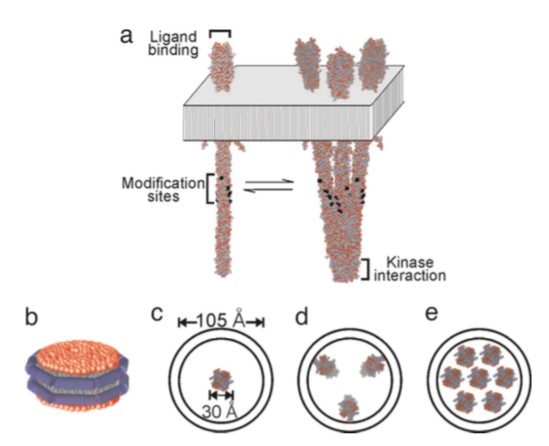Mempro™ Nanodisc for Ligand-binding Studies
Creative Biostructure has focused on the development of the novel nanodisc technology in recent years and established an advanced Mempro™ Nanodisc platform to fulfill all your requirements of our custom nanodisc products and services. Based on our advanced Mempro™ Membrane Protein platform, we have successfully incorporated a wide range of membrane proteins into nanodiscs in their functional states, allowing us to perform ligand-binding studies.
 Figure 1. Differentiation between receptor responses of a monomer of dimers and a trimer of dimers: Monomers bind the ligand and induce post-translational modifications, while trimer formation is required for maximal kinase activation. (Proc. Natl. Acad. Sci. USA, 2006)
Figure 1. Differentiation between receptor responses of a monomer of dimers and a trimer of dimers: Monomers bind the ligand and induce post-translational modifications, while trimer formation is required for maximal kinase activation. (Proc. Natl. Acad. Sci. USA, 2006)
It is very important to investigate the binding between potential drug candidates and target membrane protein receptors for drug development. Mempro™ Nanodisc technology can incorporate the membrane-anchored CYPs into nanodiscs as a promising tool to obtain these membrane proteins in a functionally active, soluble, and monodisperse form. The functions of ligand binding, adaptational modification and transmembrane signaling could be accomplished by a single dimer of chemoreceptor, however, activation of chemotaxishistidine kinase required the higher order interaction of three dimers. In previous membrane mimetic techniques, such as vesicles, the number of chemoreceptors could not be controlled but through our advanced Mempro™ Nanodisc platform the functionality of the different forms could be determined.
Creative Biostructure can applied localized surface plasmon resonance (LSPR) to detect the binding of small drug molecules to a protein. SPR measures changes in the refractive index close to the surface of a sensor chip, to which the receptor is coupled either covalently or irreversibly. Immobilization of nanodiscs on SPR sensor chips can be achieved by the use of the affinity tags on each nanodisc. A common drug target, CYP3A4, was incorporated into nanodiscs and drug binding measured through the coupling of the electronic transitions of the target protein with the surface plasmon. This technique was shown to be of use in large-scale screening of potential drugs to P450 proteins.
Besides ligand binding studies, Mempro™ Nanodisc platform has been applied on various studies of membrane proteins as well, such as protein-lipids interaction, phage display, protein-protein interaction, antibody development, and drug design, etc. Please see the related sections for more details and feel free to contact us for a detailed quote.
References:
M. Pavlidou, et al. (2013). Nanodiscs Allow Phage Display Selection for Ligands to Non-Linear Epitopes on Membrane Proteins. Plos ONE, 8(9): e72272.
J. Borch and T Hamann. (2009). The nanodisc: a novel tool for membrane protein studies. Biol. Chem., 390: 805–814.
T. Boldog, et al. (2006). Nanodiscs separate chemoreceptor oligomeric states and reveal their signaling properties. Proc. Natl. Acad. Sci. USA, 103(31): 11509–11514.